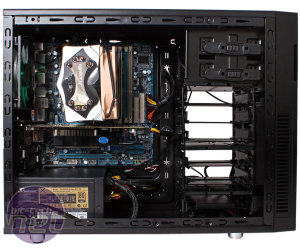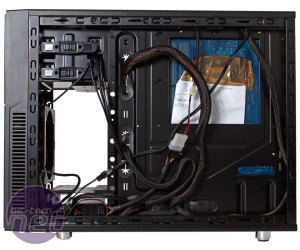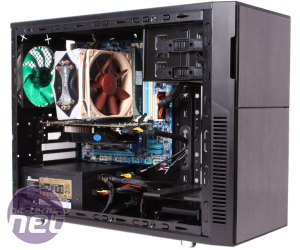
Performance Analysis
At minimum speed, the case is truly very quiet, and it lives up to its name. It does a good job of containing internal noise, though a slight hum from our hardware was still audible. Airflow from the fans is very low, however, and this is reflected in the temperatures of the CPU and GPU, both of which creeped up to the highest we've yet seen with a micro-ATX case using our current test gear. They were similar to the temperatures seen with the Aerocool Dead Silence with its closed roof installed, which is another highly insulated but quiet case.At maximum speed, the cooling situation thankfully improves by rather a lot. Airflow from the fans is noticeably more powerful, and as a result the noise output does increase. However, the case is still accurately described as quiet – even playing games at low volumes will all but drown out the fan noise here. With the improved exhaust airflow, the CPU is cooler by 9°C, going from a delta T of 62°C to 53°C. This is still a little high, as other cases are able to trump it with their fans at minimum speed. The situation is even better for the GPU, which benefits massively from the increased intake airflow. It improves by 12°C, changing from 59°C to 47°C, which is one of the best results we've seen and on par with the Corsair 350D.
With the lack of fan mounts, improving the cooling situation without swapping out fans for higher speed models (which would negate all of the low noise benefits) is tricky. We do recommend removing any unnecessary drive cages, however – the GPU ran slightly cooler when we did this. You could also remove the blanking plate from the roof fan mount to open up and ventilate the area directly above your CPU cooler. Switched from a closed to a mesh roof on the Aerocool Dead Silence Cube, for example, improved things by 4°C with no extra airflow. Removing the blanking plate here, however, will lead to noise escaping and dust entering, so fitting a filter of some sort would also be sensible.
Conclusion
We've seen some very impressive entries to the micro-ATX case market in the past year, with each one bringing something new and interesting to the table. The Deep Silence 4 is another such case, and though it doesn't deviate from the standard Deep Silence low noise design, said design is relatively unknown in the micro-ATX world. Granted, the Aerocool Dead Silence Cube aimed for low noise (and even has a similar name), but Nanoxia's focus on this aspect of things is clear everywhere you look. The case is also well built, very easy to work with and, at £65, good value too.The Aerocool chassis costs a little more, and as it lacks fan control its cooling is not as good as Nanoxia's can be, so it's the Deep Silence 4 that offers the best compromise between noise and thermals. The Deep Silence 4's main downside is the lack of available space to expand upon the default cooling, be it by water or by air, and this is hard to overlook given that it shares similar dimensions to the Fractal Arc Mini R2. Granted, Fractal's is a performance rather than a low noise chassis, and low noise enthusiasts aren't likely to want to chuck heaps of extra fans into their cases, and we also admire Nanoxia's commitment to its cause, but a few extra mounts still would have been nice to see – both the Deep Silence 1 and 2 had plenty. Now at £60, the Fractal chassis is an absolute steal and still our favourite all-round micro-ATX case. Nonetheless, if quelling noise is your top priority, and you can do without additional cooling expansion options, the Nanoxia Deep Silence 4 won't let you down elsewhere.

-
Cooling21 / 30
-
Features17 / 20
-
Design25 / 30
-
Value18 / 20


MSI MPG Velox 100R Chassis Review
October 14 2021 | 15:04












Want to comment? Please log in.